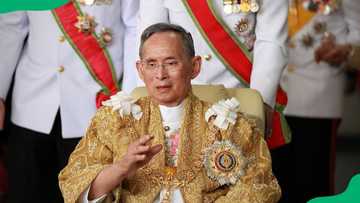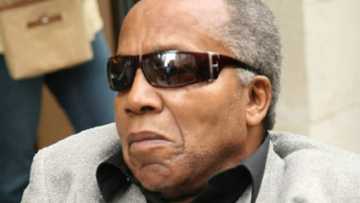Presidents on U.S. money: Who are on the coins and bills?
U.S. coins and bills carry the faces of leaders who have played significant roles in shaping the nation. Some of the most well-known presidents are among them, whose legacies are honoured through this everyday connection to history. Discover the presidents on U.S. money.

Source: Getty Images
TABLE OF CONTENTS
Like any nation, the United States uses its currency not only as a tool for commerce but also as a reflection of its heritage. The faces on coins and bills connect people to the country's rich history, showcasing leaders who shaped its identity. But who exactly are the presidents featured on U.S. money?
Presidents on U.S. money
Have you ever looked closely at the coins and bills in your wallet? They tell a story about the influential leaders who shaped the country. Each coin and bill carries a face representing a moment in history, honouring presidents who left their mark on the nation. Below is the list (coins first then bills) of presidents on U.S. money.
Presidents on U.S. coins
The process of featuring U.S. presidents on coins began in 1909 and was completed in 1964. Here is a list of presidents on U.S. coins, reflecting their enduring influence on American history.
1. Penny (1 cent): Abraham Lincoln

Source: Getty Images
The penny, or 1-cent coin, features Abraham Lincoln, the 16th president of the United States. His image was added to the coin in 1909 to mark the 100th anniversary of his birth. The Lincoln penny was the first U.S. coin to feature a president's portrait, symbolising his lasting impact on the nation's history.
Lincoln is honoured for his leadership during the Civil War and his efforts to end slavery through the Emancipation Proclamation.
2. Nickel (5 cents): Thomas Jefferson
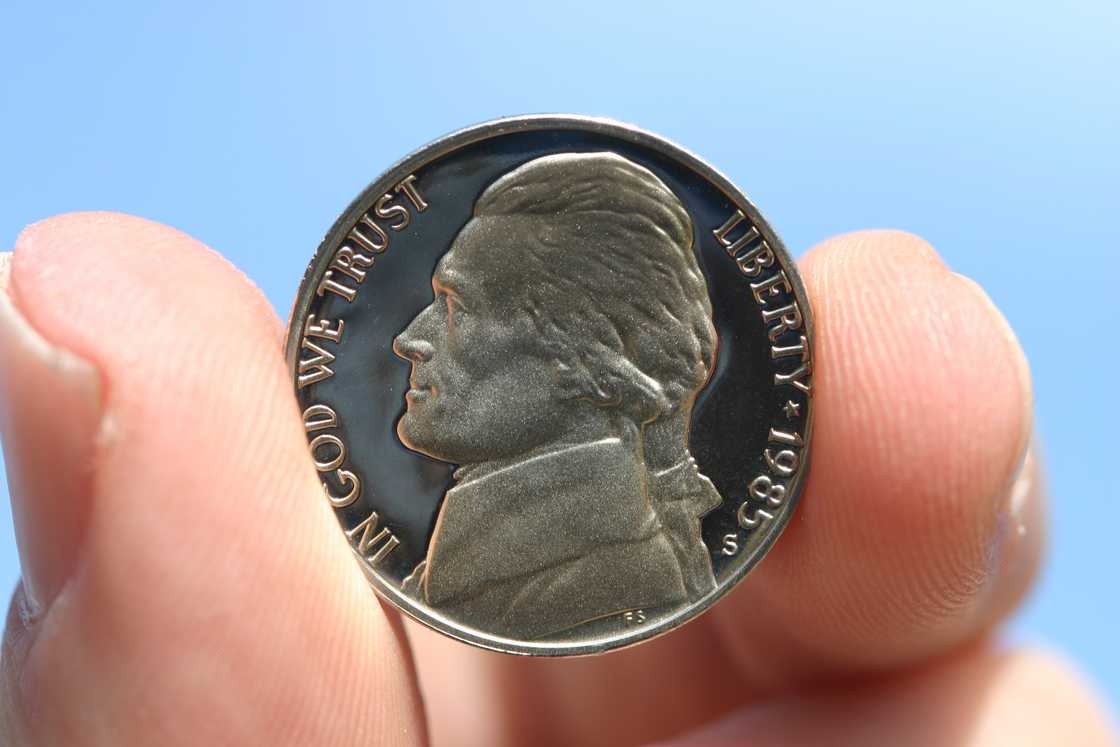
Source: Getty Images
The nickel or five-cent coin features Thomas Jefferson, the third president of the United States. He is known for drafting the Declaration of Independence and his tenure as president. The obverse shows Jefferson's profile, modelled after a portrait by Rembrandt Peale, while the reverse depicts Monticello, Jefferson's historic Virginia home.
As per the United States Mint, this design remained largely unchanged until minor updates in 2006 for added detail and historical accuracy.
3. Dime (10 cents): Franklin D. Roosevelt

Source: Getty Images
The dime features President Franklin D. Roosevelt, the 32nd president of the United States, who has been on the coin since 1946. He was chosen to honour his leadership during the Great Depression and World War II and for founding the March of Dimes to fight polio.
The dime's release was timed for Roosevelt's birthday, which was on 30 January 1946. The coin's design includes his profile on the front and symbols of liberty, peace, and strength—a torch flanked by olive and oak branches—on the reverse. Initially minted in silver, the dime switched to a copper-nickel blend in 1965 due to cost changes.
4. Quarter (25 cents): George Washington

Source: Getty Images
The U.S. Quarter features George Washington, honouring his role as the nation's first president and a founding father. This design was created by sculptor John Flanagan and was introduced in 1932 to mark Washington's 200th birthday.
According to APMEX, it was initially intended for a commemorative coin, but its popularity made it a permanent fixture in the quarter. The coin's reverse has seen various designs over the years, including eagles, state symbols, and commemorations of national parks.
5. Half dollar (50 cents): John F. Kennedy

Source: Getty Images
The half-dollar coin featured the 35th president of the United States, John F. Kennedy and was introduced in 1964, shortly after his assassination, as a tribute to his leadership. It was designed by U.S. Mint engravers Gilroy Roberts and Frank Gasparro. The coin shows Kennedy's portrait on the front and the Presidential Seal on the back.
6. Dollar coin
The 1-dollar bill features various presidents, particularly those honoured in the Presidential Dollar Coin series from 2007 to 2016. These coins were introduced to celebrate U.S. presidents and were designed with the likeness of each president on the obverse side and the Statue of Liberty on the reverse.
The series began with George Washington and included presidents in order of their terms, concluding with Ronald Reagan and George H. W. Bush. Although these coins were originally intended for circulation, their use remained limited, and production slowed after 2011.
Presidents on U.S. bills
The faces on every U.S. bill in circulation include five American presidents and two founding fathers. They are all men:
1. $1 bill: George Washington

Source: Getty Images
The 1-dollar bill features George Washington, the first president of the United States, to honour his role in the nation's founding. His image has appeared on the bill since 1869, with the current design established in 1963.
The bill's current design includes Washington's image framed by laurel leaves and other patriotic symbols. It was standardised in 1929 to align with different denominations. The motto "In God We Trust" was added in 1957, reflecting its importance in American culture.
2. $2 bill: Thomas Jefferson

Source: Getty Images
The $2 bill features Thomas Jefferson, the third U.S. president and the main writer of the Declaration of Independence. It was first issued in 1869, with Jefferson's portrait on the front and an image of the Declaration's signing added later.
The $2 bill was reintroduced in 1976 for America's Bicentennial. It honours Jefferson's role in U.S. history, though it is uncommon in everyday use.
3. $5 bill: Abraham Lincoln

Source: Getty Images
The front of the $5 bill features Abraham Lincoln, the 16th president of the United States. The bill was first introduced on U.S. currency in 1914 and initially depicted Lincoln alongside a vignette of Christopher Columbus and the Pilgrims. 1929, its size was reduced, and the Lincoln Memorial replaced the earlier imagery on the back.
4. $20 bill: Andrew Jackson

Source: Getty Images
Andrew Jackson, the seventh president of the United States, appears on the $20 bill. He was added in 1928, replacing Grover Cleveland, during a redesign of U.S. currency. The back of the bill shows the White House.
Many consider Jackson's inclusion ironic, as he strongly opposed paper money and centralised banking during his presidency. Efforts to replace Jackson's image with Harriet Tubman's have been proposed but have not yet been completed.
5. $50 bill: Ulysses S. Grant
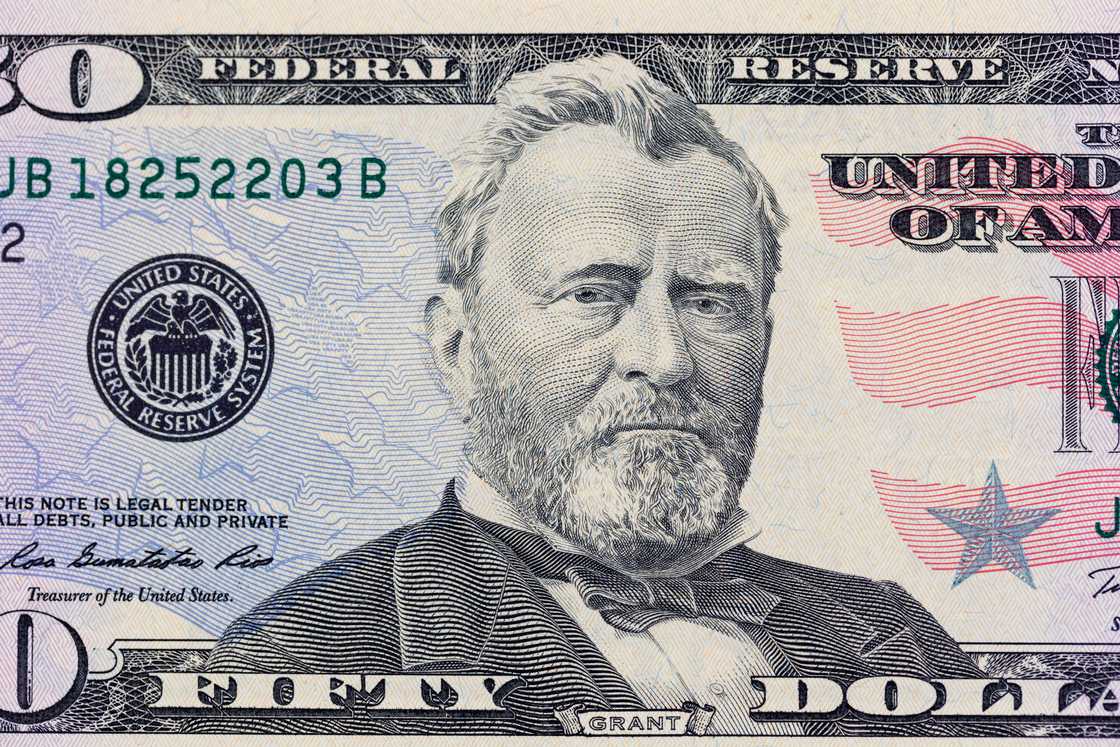
Source: Getty Images
Ulysses S. Grant, the 18th president of the United States, is featured on the $50 bill. He has appeared on the denomination since it was first issued in 1914. The Union general served two terms and helped the nation recover from the Civil War.
Bills no longer in circulation
There are other bills that are no longer in circulation. These bills also displayed the faces of other famous presidents. They include:
1. $500 bill: William McKinley
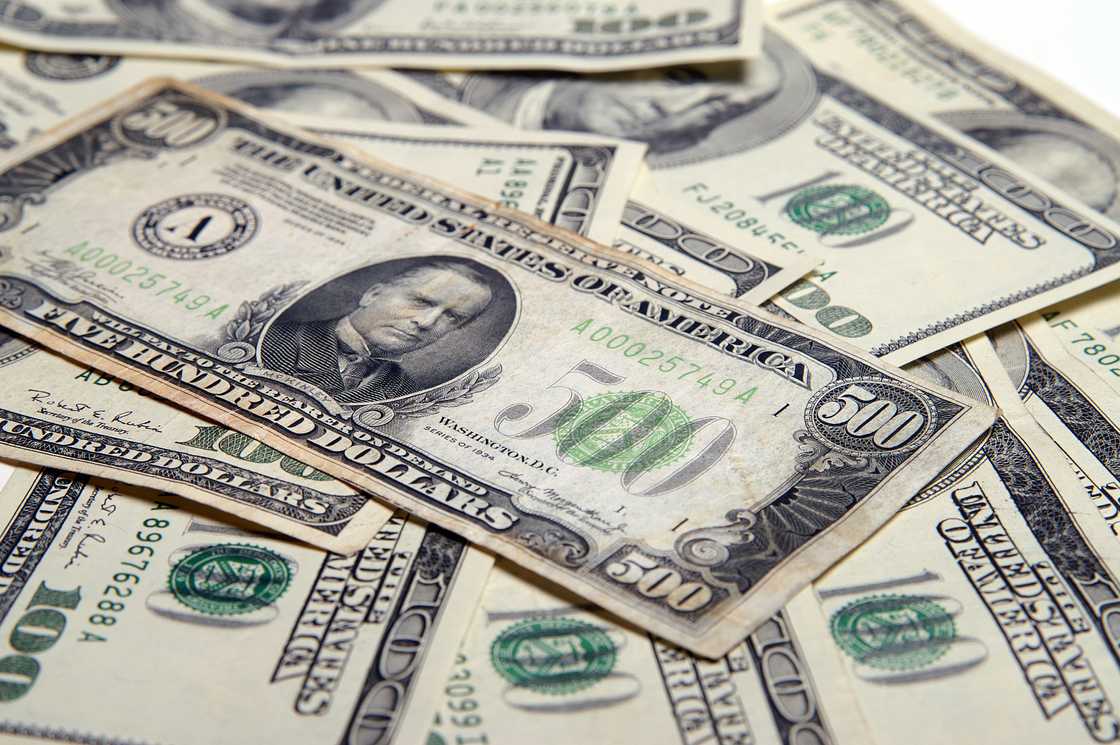
Source: Getty Images
The 25th president of the United States, William McKinley's face appears on the $500 bill, which is no longer in circulation. These bills were issued primarily in the 1928 and 1934 series and were designed for large financial transactions rather than everyday use.
While they remain legal tender, $500 bills were officially discontinued in 1969 due to declining use. They are now primarily collectors' items and are rarely seen in circulation
2. $1,000 bill: Grover Cleveland
The $1,000 bill features the portrait of Grover Cleveland, the 22nd and 24th president of the United States. It was primarily issued between 1928 and 1945 and mainly used for large bank transactions rather than everyday purchases.
The Federal Reserve discontinued the high-denomination currency in 1969 due to concerns about money laundering and limited public use. Today, $1,000 bills are rare collectables, with only a small number still in existence.
3. $5,000 bill: James Madison

Source: Getty Images
The $5,000 bill, which featured the portrait of James Madison, the fourth president of the United States, was part of a series of high-denomination currency notes issued in the 20th century. The Fed and Treasury discontinued the bill in 1969. It was last printed in 1945, but the Treasury says Americans continue to hold the notes.
4. $100,000 bill: Woodrow Wilson
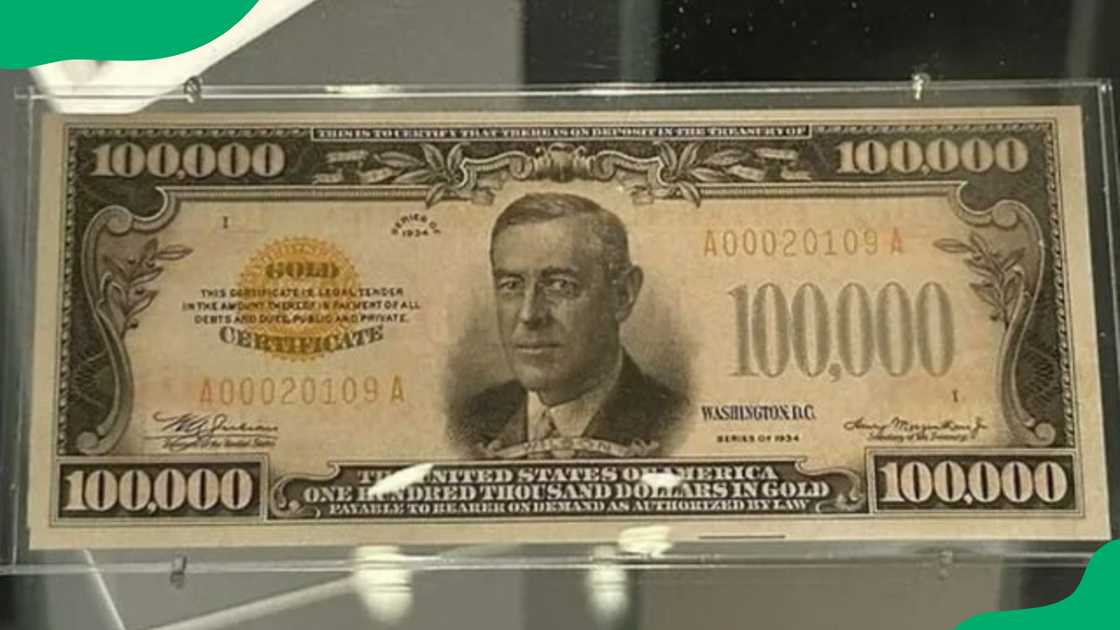
Source: Twitter
The $100,000 bill features the portrait of President Woodrow Wilson. This high-denomination note was issued in 1934, used exclusively for Federal Reserve Bank transactions, and was never circulated among the general public. It was crucial in facilitating large-scale financial transfers but was discontinued in 1969.
Who are the non-presidents on U.S. money?
While most U.S. currency features presidents, some non-presidents have also been honoured for their significant contributions to the nation's founding and development. They include:
1. $10 bill: Alexander Hamilton

Source: Getty Images
The $10 bill features Alexander Hamilton, the first Secretary of the Treasury. He is honoured for establishing the U.S. financial system and creating the nation's first central bank. According to the United States Gold Bureau, Hamilton's portrait has appeared on the bill since 1929.
2. $100 bill: Benjamin Franklin

Source: Getty Images
The $100 bill features Benjamin Franklin, one of the Founding Fathers of the United States. Franklin was a key diplomat, inventor, and writer. His portrait has appeared on the $100 bill since 1929.
3. $10,000 bill: Salmon P. Chase

Source: Facebook
The $10,000 bill features Salmon P. Chase, the U.S. Secretary of the Treasury during the Civil War. It was used primarily for large interbank transfers and was discontinued in 1968. It was the largest denomination ever printed.
Frequently asked questions
Below are some frequently asked questions about presidents on U.S. coins, shedding light on their significance and the process behind their inclusion.
Who is on the $1,000 bill?
The $1,000 bill features Grover Cleveland, the 22nd and 24th president of the United States. It was issued primarily for large transactions between banks and was discontinued in 1969 due to decreasing use.
Who are the presidents on coins?
The presidents featured on U.S. coins are Abraham Lincoln (on the penny), Thomas Jefferson (on the nickel), Franklin D. Roosevelt (on the dime), and George Washington (on the quarter).
What president is on the $100 bill?
The $100 bill features Benjamin Franklin, not a president. He was a founding father of the United States, the first Postmaster General, and the sixth President of Pennsylvania.
Why were certain presidents on money?
Some U.S. presidents were chosen to appear on money because of their significant contributions to the nation's history. The individuals played pivotal roles in shaping the country's values, ideals, and governance.
Which president faces to the right on US coins?
President Abraham Lincoln is the only president facing right on a coin. All the others face left.
The presidents on U.S. money are a tribute to some of the country's most influential leaders. Many presidents who helped shape the history of the United States are honoured on its currency. From coins like the penny and nickel to bills like the $1 and $20, each piece tells a story about the nation's past and the leaders who played key roles in its growth.
READ ALSO: Most famous people in the world: Who are they?
Briefly.co.za published an article about the most famous people in the world. The most famous people in the world come from various fields such as entertainment, sports, politics, and technology.
These individuals are widely recognised for their achievements and influence, and their names are often on the lips of millions. From movie stars and athletes to tech moguls and political figures, the list of famous people continues to evolve as they make their mark on the world stage.
Source: Briefly News

